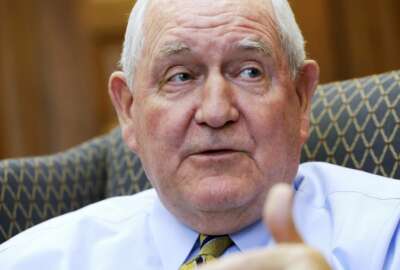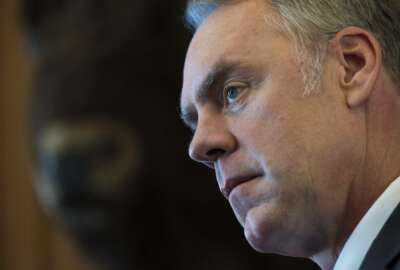
Why OMB should change the name of the management agenda
The administration will release more details about its management agenda later this month with a focus on three outcomes.
Best listening experience is on Chrome, Firefox or Safari. Subscribe to Federal Drive’s daily audio interviews on Apple Podcasts or PodcastOne.
When the Office of Management and Budget unveils more details about its new management agenda later this month, Margaret Weichert, the deputy director for management, may want to consider a name change as well.
Instead of calling it a management agenda, maybe she should call it a people agenda?
If you think about it, the driving force behind any major change, or, as OMB called it in the fiscal 2019 budget request to Congress last month, creating “deep-seated transformation” efforts begins and ends with people.
“A lot of what we’ve tried to do with the management agenda is really listening to the feedback we are getting from the employees about the problems they are facing, what can we do here to unlock some of those barriers, what can we do to give them more tools and capabilities and empower them more and give them more autonomy in their decision making and their day-to-day,” said Dustin Brown, the OMB’s deputy associate director for performance and personnel management, at the recent Association of Government Accountants National Leadership Training event in Washington, D.C. “That’s an important concept that we need to continue to come back to.”
Brown said this need was clearly evident during the response to the hurricanes in the southeast and wild fires in the west.
“When a crisis hits, if you look at how we manage, it’s extraordinary. The organizational siloes and boundaries that so often get in our way immediately falls apart and everyone is focused on that mission,” he said. “There is a really great cadence. I’d love to find ways to bring that spirit to some of those longer-term enduring problems.”
And the reason why the government coalesces as one is because of the people involved in the effort.
When the goal is obvious—get food and medicine to hurricane ravaged towns and cities—it’s easier to break down those barriers.
When the goal is less obvious, it’s easier for barriers to seem indestructible.
These observations aren’t groundbreaking or even new, but what stands out now more than ever is the need for people to drive the change.
Let’s take a look at the six pillars of the management agenda OMB says it will focus on as outlined in the budget request:
- Modernizing IT to increase productivity and security;
- Creating a 21st century framework for data that drives efficiency, accountability, and transparency;
- Developing a workforce for the 21st century;
- Improving the customer experience with federal services;
- Shifting from low-value to high-value work; and
- Improving the efficiency and effectiveness of administrative services across government.
Each one of these are going to be driven by the people. OMB should focus on them instead of on some ubiquitous and potentially meaningless term, “management,” and that might help refactor the efforts.
Keep in mind, agencies have been focused on a “management agenda” for the past 16 years so while a name change may be cosmetic, it also could bring a refreshed view to the discussions.
And, maybe more importantly, it would send a message to the agencies that seem to have a distorted view of how to move mission forward—see the departments of Agriculture and Interior recent reorganization efforts that many employees say are being done to them and not with them.
Let’s take this idea of a people agenda one step further.
Brown said at AGA that OMB developed the management agenda with three outcomes in mind:
- Improve mission delivery
- Provide better customer services and experiences with federal services with goal of trying of having federal services meet or exceed industry benchmarks. He said there is a pretty good gap there.
- More effective stewardship of taxpayer funds.
By hiring the right people, mission delivery likely will improve.
People drive the goal of better customer service.
And the final outcome of effective stewardship can only happen if the administration empowers employees to make decisions and bring potential waste or abuse to the forefront.
“We just sent up to Congress a list of 402 reports that Congress mandate we do and we think are unnecessary and we want to eliminate,” Brown said. “One example of that is the Plain Language Writing Act of 2010. It’s a great example of something from the President’s Management Council where somebody came up and said, ‘this may have had a good intention at the beginning, but we should be able to hold ourselves accountable for doing a better job in how we write and communicate. We don’t need a senior accountable official and an annual report.”
Brown said by eliminating examples like this one would free up employees to do more valuable and productive work.
He said one way to further breakdown siloes is by retraining employees as automation and other changes such as shared services to the work agencies do helps move them from low-valued to high valued work.
As Brown said at AGA, there are things the administration can do fairly easily to affect people change and there are things that they need congressional help on and will not be so easy or happen quickly.
Brown said OMB and the Chief Human Capital Officers Council already has had meetings with Sen. James Lankford (R-Okla.), the chairman of the Homeland Security and Governmental Affairs Subcommittee on Regulatory Affairs and Federal Management, about some potential legislative priorities.
“The number one law this group [AGA] wanted to see change was around hiring and giving people more flexible tools like direct hire authority to cut through the process a little more effectively. We are working with OPM on a number of different issues here to try to give agencies better tools and I expect we will move forward with that,” he said. “We have submitted a number of legislative proposals to Congress to try to, for instance, give you direct hire for interns. That is something I know that we used to have and we don’t today. We need to get that back. DoD has it. They got it about a year or two ago and we are trying to extend that governmentwide.”
The release of the management agenda comes as every agency updated their individual strategic plans. Brown said this is the first time every agency did this at the same time.
“It’s a very important cycle to get on and this is aligned with the Presidential terms. It gives us a chance to really definitively say, ‘these are the outcomes of the federal government and this is our bottom line,” he said. “For my purpose, we have 285 outcomes that we have identified in the agencies’ strategic plans. You can see them all on Performance.gov.”
Browns said leadership also committed to specific, measurable implementation-focused agency priority goals. There are 70 on performance.gov and agencies will add another 15 or so in the coming weeks.
OMB will issue new guidance in the coming weeks as well to detail how the strategic review process will work to hold agencies accountable for their goals.
“It will focus on the assessment agencies do on how well they are performing on the mission strategic objectives. We’ve asked agencies to do a forced ranking so they have to tell us what’s going well and what’s not going well,” Brown said. “The second area that will be a focus for those spring strategic review meetings is risk management. I know folks have been following closely and have been doing a lot of work to put an enterprise risk management framework in place through an OMB Circular guidance. That is coming to fruition for the first time. We will have a comprehensive assessment of risk agencies have identified for financial, mission, programmatic and operational risks.”
The third area of the reviews will focus on barriers, whether procurement or hiring or whatever is stopping agencies from succeeding in their missions.
“One of the real benefits the leadership team from OMB has brought in is a commitment to focus on the long-term. We don’t want to do something that is about quick wins, although those are certainly welcome as well,” he said. “We want to do something that really will be multi-generational and deals with these core structural issues and will persist over time.”
And the best way to get at these core structure issues is by having great people who are part of the solution and not seen as an impediment.
Read more of the Reporter’s Notebook.
Copyright © 2024 Federal News Network. All rights reserved. This website is not intended for users located within the European Economic Area.
Jason Miller is executive editor of Federal News Network and directs news coverage on the people, policy and programs of the federal government.
Follow @jmillerWFED
Related Stories

Secretary’s ‘OneUSDA’ vision rings hollow to some in light of new telework policy





